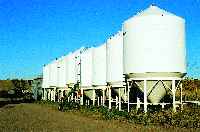| | Storage | Mixing and loading | Disposal
Storage
Fertilizers and manure need to be stored safely to avoid hazards to people, animals and the environment.
Amount stored
The best approach is to store only the amount of fertilizer you need for your immediate use. This reduces the risk of a major spill or other accident. If product needs to be stored, it is recommended that it be secured in a strong, stable, dry structure with a good roof and a cement floor, where moisture, rain and surface water cannot enter.
Storage facility
- Ensure that the storage facility is secure. This means a locked fenced area, locked building or storage structure separate from all other activities that could damage the containers or spill fertilizer.
- Post signs stating the contents of the facility in case of fire.
- Ensure that the facility is located more than 100 m (330 ft) from water wells and more than 20 m (60 ft) from surface water bodies.
- Do not store fertilizers with fuel, food, feed, seed, drinking water or protective equipment to prevent contamination of these.
- Monitor the storage site regularly for leaks and spills.
Emergency plan
Prepare an emergency plan in place in case of a leak or spill. This written plan should include the location of emergency equipment, emergency telephone numbers, cleanup methods and steps to follow.
Dry fertilizer storage
Dry fertilizer should be stored in a building or epoxy-lined bin on an impermeable surface such as sealed concrete.
Liquid fertilizer storage
- Regularly inspect all tanks, valves and plumbing used for liquid fertilizer storage.
- Around the primary storage container, install an impermeable synthetic or clay liner for secondary containment to stop any spills and leaks from entering soil or water.
- Use sight gauges and lock-on valves on containers.

Commercial fertilizers need to be stored safely to avoid hazards to people, animals and the environment.
Courtesy of ARD
Manure storage and treatment -For information on manure storage and treatment, see:
Mixing and Loading
When mixing and loading fertilizers, it is inevitable that a spill will occur eventually. Using proper procedures and precautions will minimize or eliminate the risk of contamination from spills.
Follow these guidelines for proper fertilizer mixing and loading:
- Clean up spills when they occur.
- For dry fertilizer, if you use a permanent mixing and loading area, the mixing pad should be impermeable. Sweep up any spilled dry fertilizer, and store it in a clean container until it can be used.
- For wet fertilizer, if you use a permanent mixing and loading area, ensure that any spills or leaks can be collected and contained. The mixing pad should have an impermeable floor, curbs and a sump.
- For mixing wet fertilizers, either have a backflow preventer on the water supply or ensure that there is a 15-cm (6-inch) air gap between the water and the hose. If possible, use a closed handling system to transfer the fertilizer directly from the storage container to the applicator equipment, so people and the environment are not exposed to the fertilizer.
- Do not leave filling equipment unattended.
- Ensure that loading takes place at least 30 m (100 ft) away from a well or surface water.
- If loading fertilizers in the field, make sure to use different sites to prevent buildup.
Disposal
Guidelines for disposal of fertilizer rinsate and packaging are:
- Apply fertilizer rinsate to a cropped area at a distance greater than 10 m (33 ft) from any surface water source and greater than 60 m (200 ft) from any well.
- To dispose of dry fertilizer bags, bundle the completely empty bags and dispose of them at a licensed landfill.
- For more information, see the Canadian Association of Agri-Retailers' Fertilizer Storage and Handling.
Back to Chapter 4 - Storage, Handling and Disposal of Agricultural Inputs |
|